Ancient Nessebar – 3,000-Year-Old History Of Many Civilizations
AncientPages.com - Ancient Nessebar, located at a peninsula in the Black Sea, has been known since ancient times.
In this more than 3,000-year-old city, many civilizations left their traces and its history is fascinating. From the beginning, Nessebar was a Thracian settlement, known as Menebria or Mesembria and founded in the 2nd millennium BC.
Archaeologists have unearthed remains of dwellings, stone anchors and a variety of pottery dated to Late Bronze Age (1500 - 1200 BC), as well as from the Early Iron Age (1200-700 BC). In addition, a fortress wall and gateway, unearthed not long ago prove that the first settlement on the Nesssebar Peninsula eventually became a Thracian city.
Greek geographer Strabo (c. 63 BC - AD 24) explains the origin of the city's name and writes as follows:
'Then [comes] Mesembria, a colony of the Megarians, formerly called Menebria (that is, `city of [Thracian king] Menas', because the name of its founder was Menas, while `bria' is the word for 'city' in the Thracian language)."
The actual meaning of the name and the memory of the legendary ruler of the seas, the Thracian king Menas (or 'Melsas'), have been preserved for centuries by the indigenous people and the Greek colonists who settled in this region and the city became a Greek colony at the beginning of the 6th century BC.
Nessebar was known as Mesembria-Mesemvria when the Christian age began and later during the Roman and Byzantine Empires. It was influenced by the culture of the ancient Aegean civilization made up of different peoples, legendary figures and memorable historical events.

The ruins of Nessebar date back to the Hellenistic period and they include a temple of Apollo,an agora and the remains of the acropolis. Photo: dnd travel
The ruins of Nessebar date back to the Hellenistic period and they include a temple of Apollo, an agora and the remains of the acropolis. Also, a wall, which formed part of the Greek fortifications, can still be seen on the north side of the peninsula.
Bronze and silver coins were minted in this flourishing city since the 5th century BC and gold coins since the 3rd century BC. It was also a thriving port in Greek and Roman times, but its importance as a port for ships sailing between Constantinople and the Danube, became obvious, first, during the Byzantine era.

Nessebar was captured and incorporated in the lands of the First Bulgarian Empire in 812 by Khan Krum after a two week siege only to be surrendered back to Byzantium.
This privilege to mint the city’s own coinage was still preserved when Nessebar fell under Roman rule in 71 BC.
We learn from ancient records that Nessebar was one of the most important strongholds of the Byzantine Empire from the 5th century AD onwards.

Nessebar was captured and incorporated in the lands of the First Bulgarian Empire in 812 by Khan Krum after a two week siege only to be surrendered back to Byzantium. Photo: https://www.flickr.com/people/24160703@N03/
Its history was very turbulent, because it was fought over by Byzantines and Bulgarians. It was passed from Byzantine to Bulgarian ownership several times throughout the Middle Ages.
In the 7th - 8th century, Nessebar was flourishing medieval city full of rich local merchants and precious works of art, fabrics, vessels and household objects.
The city was captured and incorporated in the lands of the First Bulgarian Empire in 812 by the invincible Bulgarian warlord, Tsar Khan Kroum (803-814) who conquered Nessebar (Mesemvria) in 812. This incident briefly threatened the security of the Byzantine Empire, but under the next leader the Bulgarian Tsar Ivan Alexander (1331-1371), the city began to prosper again.
Later, it was conquered by Crusaders led by Amadeus VI, Count of Savoy in 1366 and captured by the Turks in 1453, which contributed to Nessebar's decline, but still its architectural heritage miraculously remained and was even enriched.
This was very remarkable ancient city, which even in its dying days, it could still continue to thrive.
AncientPages.com
source: Pou-Nesebar-org
More From Ancient Pages
-
 Among Ancient Maya Cacao Was Used In Celebrations And Was Common To All People
Archaeology | Sep 27, 2022
Among Ancient Maya Cacao Was Used In Celebrations And Was Common To All People
Archaeology | Sep 27, 2022 -
 Fascinating Ancient And Unexplained Mysteries Of Arizona – Secrets Of The Canyons And Mountains – Part 1
Featured Stories | Sep 29, 2024
Fascinating Ancient And Unexplained Mysteries Of Arizona – Secrets Of The Canyons And Mountains – Part 1
Featured Stories | Sep 29, 2024 -
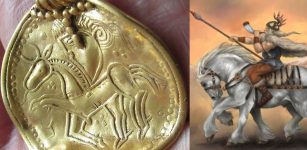 Discovered Gold Pendant Of Odin And His Horse Sleipnir Might Be Linked To The Heruli Tribe
Archaeology | Apr 16, 2016
Discovered Gold Pendant Of Odin And His Horse Sleipnir Might Be Linked To The Heruli Tribe
Archaeology | Apr 16, 2016 -
 Evidence Of Yue – Ancient Chinese Criminal Punishment Found At Sanmenxia City
Archaeology | May 17, 2024
Evidence Of Yue – Ancient Chinese Criminal Punishment Found At Sanmenxia City
Archaeology | May 17, 2024 -
 Another 2,000-Year-Old ‘Snack Bar’ Discovered In Pompeii
Archaeology | Apr 10, 2019
Another 2,000-Year-Old ‘Snack Bar’ Discovered In Pompeii
Archaeology | Apr 10, 2019 -
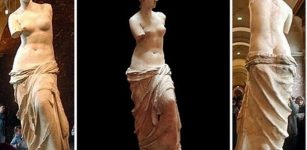 On This Day In History: Statue Of Venus de Milo Is Discovered On The Aegean Island Of Milos – On Apr 8, 1820
News | Apr 8, 2016
On This Day In History: Statue Of Venus de Milo Is Discovered On The Aegean Island Of Milos – On Apr 8, 1820
News | Apr 8, 2016 -
 On This Day In History: Samuel Morey Patents The Internal Combustion Engine – On April 1, 1826
News | Apr 1, 2017
On This Day In History: Samuel Morey Patents The Internal Combustion Engine – On April 1, 1826
News | Apr 1, 2017 -
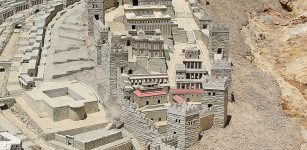 Has a 2,000 Year Old Podium Been Found in the City of David?
Civilizations | Sep 2, 2015
Has a 2,000 Year Old Podium Been Found in the City of David?
Civilizations | Sep 2, 2015 -
 Kava – Astonishing Ancient Plant That Improves Emotional Intelligence Is Gaining Popularity In The Western World
Featured Stories | Mar 31, 2018
Kava – Astonishing Ancient Plant That Improves Emotional Intelligence Is Gaining Popularity In The Western World
Featured Stories | Mar 31, 2018 -
 Ganesha: Elephant-Headed God Of Knowledge, Learning, Literature And Scribe Of The Mahabharata
Featured Stories | Aug 17, 2016
Ganesha: Elephant-Headed God Of Knowledge, Learning, Literature And Scribe Of The Mahabharata
Featured Stories | Aug 17, 2016 -
 Secrets Of The Melsonby Hoard – Largest Iron Age Treasure In The UK
Archaeology | Mar 27, 2025
Secrets Of The Melsonby Hoard – Largest Iron Age Treasure In The UK
Archaeology | Mar 27, 2025 -
 Did Ancient Seafarers In Southeast Asia Build Sophisticated Boats As Far Back As 40,000 Years Ago?
Archaeology | Feb 24, 2025
Did Ancient Seafarers In Southeast Asia Build Sophisticated Boats As Far Back As 40,000 Years Ago?
Archaeology | Feb 24, 2025 -
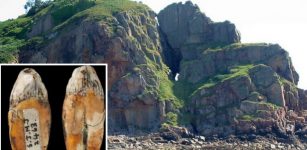 Evidence Of A Hybrid Population Of Neanderthals And Modern Humans Discovered At La Cotte De St Brelade
Archaeology | Feb 9, 2021
Evidence Of A Hybrid Population Of Neanderthals And Modern Humans Discovered At La Cotte De St Brelade
Archaeology | Feb 9, 2021 -
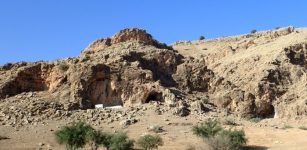 Early Humans In The Paleolithic Age Had A More Varied Diet Than Previously Assumed
Archaeology | Nov 29, 2023
Early Humans In The Paleolithic Age Had A More Varied Diet Than Previously Assumed
Archaeology | Nov 29, 2023 -
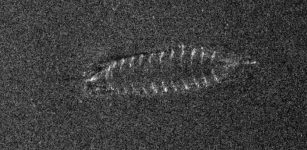 Sonar Images Reveal The Existence Of A 700-Year-Old Shipwreck At The Bottom Of Lake Mjøsa, Norway
Archaeology | Nov 22, 2022
Sonar Images Reveal The Existence Of A 700-Year-Old Shipwreck At The Bottom Of Lake Mjøsa, Norway
Archaeology | Nov 22, 2022 -
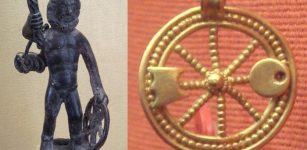 Taranis – Celtic God Of Wheel And Thunder Resembled Roman God Jupiter
Celtic Mythology | Jul 15, 2019
Taranis – Celtic God Of Wheel And Thunder Resembled Roman God Jupiter
Celtic Mythology | Jul 15, 2019 -
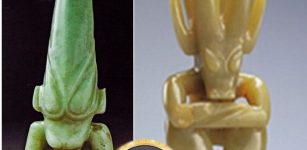 Ancient Hongshan Culture: Creators Of A Pyramid And Remarkable Artifacts That Are Still Shrouded In Mystery
Ancient Mysteries | Jun 20, 2015
Ancient Hongshan Culture: Creators Of A Pyramid And Remarkable Artifacts That Are Still Shrouded In Mystery
Ancient Mysteries | Jun 20, 2015 -
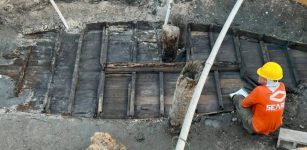 Remarkable Discovery Of A 19th-Century Boat Buried Under A Road In St. Augustine, Florida
Archaeology | Oct 16, 2023
Remarkable Discovery Of A 19th-Century Boat Buried Under A Road In St. Augustine, Florida
Archaeology | Oct 16, 2023 -
 Mysterious Melchizedek: ‘King Of Righteousness’ And Heavenly High Priest In Bible And Dead Sea Scrolls
Biblical Mysteries | Sep 2, 2017
Mysterious Melchizedek: ‘King Of Righteousness’ And Heavenly High Priest In Bible And Dead Sea Scrolls
Biblical Mysteries | Sep 2, 2017 -
 Impressive 9,000-Year-Old Stone Mask Uncovered In Southern Hebron Hills, Israel
Archaeology | Nov 30, 2018
Impressive 9,000-Year-Old Stone Mask Uncovered In Southern Hebron Hills, Israel
Archaeology | Nov 30, 2018

